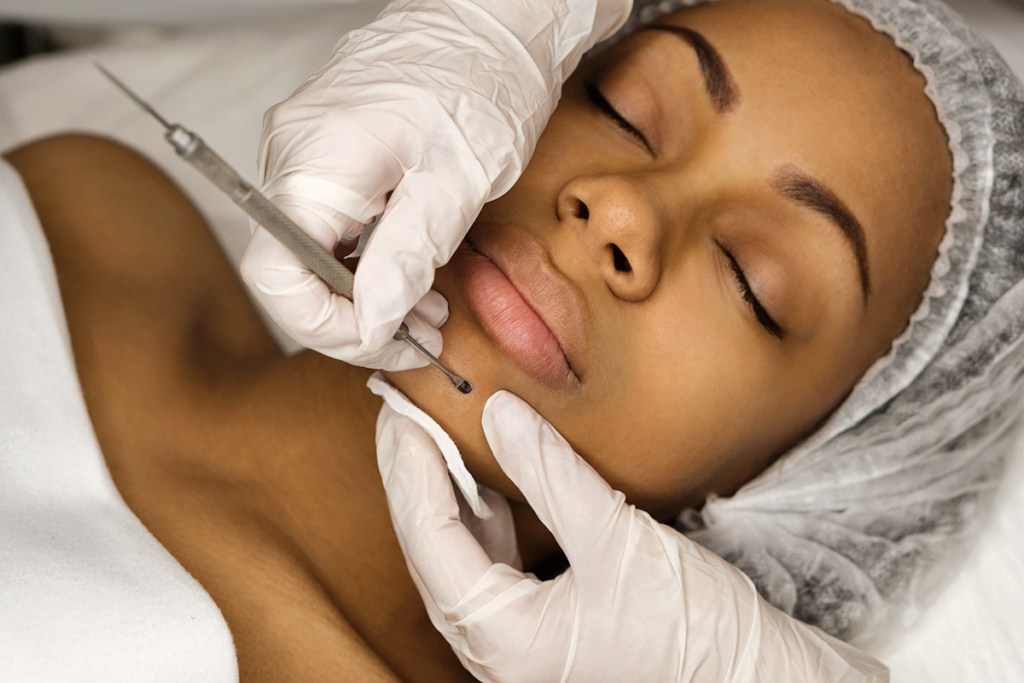A facial extraction is a procedure to clear clogged or blocked pores. This guide will tell you everything you need to know about extractions, including what they are, how they work, and if they’re right for you. We’ll cover topics like blackhead removal, comedone extraction, acne treatment, skin purging, and pore cleansing, explaining how professional extraction can help you achieve clear skin.

Image Source: dermsos.com
Fathoming Facial Extractions
A facial extraction is a skin care procedure that removes impurities from pores. These impurities can include excess oil, dead skin cells, and dirt. Extractions are often part of a deep cleansing facial and can help improve skin texture and appearance.
Why Extractions Are Performed
Think of your pores as tiny openings on your skin. They can get clogged by things like:
- Sebum: Natural oil your skin makes.
- Dead Skin Cells: Old skin cells that haven’t shed.
- Dirt and Debris: Things from the environment that land on your skin.
- Cosmetics: Makeup and other products.
When these things block a pore, it can lead to different types of facial blemishes, such as:
- Blackheads: Open pores with a dark surface.
- Whiteheads: Closed pores with a white or flesh-colored bump.
- Pimples: Inflamed, pus-filled bumps.
Differentiating Extraction from Other Treatments
Extractions focus on physically removing blockages from pores. Other treatments, like chemical peels or microdermabrasion, exfoliate the skin’s surface. While these treatments can help prevent clogged pores, they don’t directly remove existing blockages like extractions do.
| Treatment | Main Action | Focus |
|---|---|---|
| Facial Extraction | Removes pore blockages | Clogged Pores |
| Chemical Peel | Exfoliates skin | Skin Surface & Texture |
| Microdermabrasion | Exfoliates skin | Skin Surface & Texture |
Who Benefits from Facial Extractions?
Facial extractions are good for people with:
- Oily Skin: People with oily skin often have more clogged pores.
- Acne-Prone Skin: Extractions can help control breakouts.
- Visible Blackheads and Whiteheads: Extractions directly target these blemishes.
Cases Where Extractions May Not Be Suitable
Extractions may not be good for you if you have:
- Inflamed Acne: Extracting inflamed pimples can worsen them.
- Sensitive Skin: Extractions can irritate sensitive skin.
- Certain Skin Conditions: People with eczema or rosacea should be careful.
Consultation Is Key
Before getting an extraction, talk to a dermatologist or esthetician. They can check your skin and tell you if extractions are safe and helpful for you.
Professional Extraction vs. At-Home Extraction
It’s best to get extractions done by a professional. Trying to do them yourself can harm your skin.
The Risks of At-Home Extractions
Doing extractions at home can lead to:
- Infection: Dirty tools can spread bacteria.
- Scarring: Squeezing too hard can damage your skin.
- Inflammation: Picking can make acne worse.
- Skin Damage: Incorrect techniques can injure your skin.
What to Expect During a Professional Extraction
A professional extraction usually includes these steps:
- Cleansing: Your skin is cleaned to remove dirt and makeup.
- Steam: Steam softens the skin and opens pores.
- Exfoliation: A scrub or peel removes dead skin cells.
- Extraction: The esthetician uses special extraction tools to remove blockages.
- Treatment: A mask or serum is applied to soothe and protect the skin.
Extraction Tools Used by Professionals
Professionals use special extraction tools to safely remove blockages:
- Comedone Extractors: These tools have loops or cups to gently push out blackheads and whiteheads.
- Lancets: A small, sterile needle to create a tiny opening in closed comedones (whiteheads).
The Extraction Process: A Step-by-Step Look
Here is a closer look at what happens during a professional extraction:
Preparation: Cleansing and Steaming
First, your skin is cleaned to remove any makeup, oil, and dirt. Then, steam is used to soften the skin and open up the pores. This makes it easier to remove blockages.
The Extraction Technique
The esthetician uses extraction tools to carefully remove blackheads and whiteheads. They may also use a lancet to create a small opening for stubborn whiteheads. The esthetician applies gentle pressure to remove the blockage without damaging the skin.
Soothing the Skin Post-Extraction
After the extractions, a soothing mask or serum is applied to calm the skin and reduce redness. This helps to prevent inflammation and irritation.
Integrating Extractions into Your Skin Care Routine
Extractions are not a one-time fix. They work best when combined with a good skin care routine.
Building a Solid Foundation
A good skin care routine includes:
- Cleansing: Wash your face twice a day to remove dirt and oil.
- Exfoliating: Use a gentle scrub or chemical exfoliant once or twice a week to remove dead skin cells.
- Moisturizing: Keep your skin hydrated with a moisturizer.
- Sunscreen: Protect your skin from the sun with sunscreen every day.
Aftercare Tips for Optimal Results
After an extraction, follow these tips:
- Avoid Touching Your Face: Keep your hands off your face to prevent infection.
- Use Gentle Products: Avoid harsh scrubs or chemicals.
- Stay Hydrated: Drink plenty of water to keep your skin hydrated.
- Apply a Soothing Mask: Use a calming mask to reduce redness and inflammation.
The Role of Regular Facials
Getting regular facials can help maintain clear skin. Facials can include extractions, exfoliation, and other treatments to keep your skin healthy.
Acne Treatment and Facial Extractions
Extractions can be a helpful part of acne treatment.
How Extractions Support Acne Management
Extractions can help remove blockages that lead to acne. By clearing clogged pores, extractions can reduce the number of breakouts.
Combining Extractions with Other Treatments
Extractions work best when combined with other acne treatments, such as:
- Topical Medications: Creams and gels that contain ingredients like benzoyl peroxide or salicylic acid.
- Oral Medications: Pills that help control acne, such as antibiotics or isotretinoin.
- Light Therapy: Treatments that use light to kill bacteria and reduce inflammation.
What Is Skin Purging
Skin purging is a reaction to certain skin care ingredients that speed up skin cell turnover. This can cause breakouts as impurities are pushed to the surface. It is important to know the difference between skin purging and a breakout because skin purging is temporary. Extractions can help speed up the process.
| Feature | Skin Purging | Breakout |
|---|---|---|
| Cause | New, active ingredients | Clogged pores, bacteria, hormones |
| Location | Areas where you commonly break out | New areas |
| Duration | Short-term (2-6 weeks) | Longer-term |
| Appearance | Small, similar blemishes | Variety of blemishes (pimples, cysts) |
| Treatment | Continue using the product (if tolerated) | Treat the underlying cause (e.g., acne) |
Facial Blemishes: Prevention and Maintenance
Preventing clogged pores is key to clear skin.
Lifestyle Changes for Clearer Skin
Some lifestyle changes that can help prevent clogged pores include:
- Eating a Healthy Diet: Avoid processed foods and sugary drinks.
- Staying Hydrated: Drink plenty of water.
- Getting Enough Sleep: Aim for 7-8 hours of sleep per night.
- Managing Stress: Find healthy ways to manage stress, such as exercise or meditation.
Pore Cleansing: Daily Habits
Daily habits that can help keep your pores clear include:
- Washing Your Face Twice a Day: Use a gentle cleanser.
- Removing Makeup Before Bed: Never sleep with makeup on.
- Using Non-Comedogenic Products: Choose products that won’t clog pores.
Long-Term Skin Health
Taking care of your skin is a long-term commitment. By following a good skin care routine and making healthy lifestyle choices, you can keep your skin clear and healthy.
Common Myths About Facial Extractions
Let’s clear up some common misconceptions about facial extractions:
| Myth | Reality |
|---|---|
| Extractions are a one-time solution. | Extractions are most effective when combined with a consistent skincare routine. |
| At-home extractions are safe. | At-home extractions can lead to infection, scarring, and further skin damage if not performed correctly. |
| Extractions can cure acne. | Extractions can help manage acne by removing pore blockages, but they are not a standalone cure. |
| All skin types benefit from extractions. | Extractions may not be suitable for sensitive or inflamed skin. Consulting with a professional is essential before proceeding. |
Grasping Potential Side Effects
While generally safe, extractions can sometimes cause side effects. Knowing what to expect helps you manage them effectively.
Possible Reactions and How to Handle Them
- Redness and Inflammation: These are common immediately after an extraction. Apply a cold compress and use soothing skincare products to alleviate them.
- Temporary Breakouts: Sometimes, extractions can cause a temporary increase in breakouts as underlying impurities surface.
- Dryness or Peeling: Some people may experience dryness or peeling, especially if exfoliating products are used during the facial. Moisturize regularly to combat this.
- Hyperpigmentation: In rare cases, especially with aggressive extractions, hyperpigmentation (darkening of the skin) can occur. Sunscreen is crucial to prevent this.
When to Seek Professional Advice
Consult a dermatologist or skincare professional if you experience:
- Severe or Prolonged Redness: If redness persists for more than a few days.
- Signs of Infection: Such as increased pain, swelling, pus, or fever.
- Persistent Breakouts: If you notice a significant increase in breakouts that don’t subside.
- Scarring: Any signs of scarring should be assessed by a professional to prevent permanent damage.
FAQ: Answering Your Questions
Here are some frequently asked questions about facial extractions:
What is the best way to prepare for a facial extraction?
The best way to prepare is to avoid using harsh exfoliants or retinoids for a few days before your appointment. Make sure your skin is clean and free of makeup.
Can I do extractions on myself?
It’s generally not recommended to perform extractions on yourself. At-home extractions can lead to infection, scarring, and further skin damage.
How often should I get a facial extraction?
The frequency depends on your skin type and concerns. Most people benefit from extractions every 4-6 weeks.
Who is qualified to perform facial extractions?
Dermatologists, estheticians, and trained skincare professionals are qualified to perform facial extractions.
Can extraction help with cystic acne?
Extractions are not typically recommended for cystic acne. Cystic acne is deep and inflamed, and extractions can worsen the inflammation and cause scarring. A dermatologist can recommend appropriate treatments for cystic acne.
Are facial extractions painful?
Some discomfort may be felt during extractions, but it shouldn’t be overly painful. A skilled esthetician will use gentle techniques to minimize discomfort.
Will my skin look worse before it gets better after an extraction?
It’s possible for your skin to look slightly worse immediately after an extraction due to redness and inflammation. However, this is temporary, and your skin should improve within a few days.
By combining professional extractions with a consistent skincare routine and healthy lifestyle habits, you can achieve and maintain clear, healthy skin.

I’m Carrie Kelly, the creator behind Gotham Beauty Lounge. Beauty is my passion, and I’ve made it my mission to bring you all the latest trends, expert tips, and honest reviews to help you elevate your beauty game. With a love for all things bold, edgy, and elegant, I believe makeup is an art form, and skincare is self-care. On my blog, I share my personal experiences, favorite products, and advice for embracing your unique beauty. Join me on this exciting journey to feel confident, empowered, and, most importantly, to always look and feel your best!
